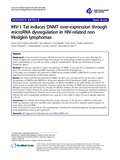HIV-1 Tat induces DNMT over-expression through microRNA dysregulation in HIV-related non Hodgkin lymphomas

View/
Date
2014-12-09Author
Luzzi, Anna
Morettini, Federica
Gazaneo, Sara
Mundo, Lucia
Onnis, Anna
Mannucci, Susanna
Rogena, Emily A
Bellan, Cristiana
Leoncini, Lorenzo
De Falco, Giulia
Type
Journal ArticleMetadata
Show full item recordAbstract
Abstract
Background
A close association between HIV infection and the development of cancer exists. Although the advent of highly active antiretroviral therapy has changed the epidemiology of AIDS-associated malignancies, a better understanding on how HIV can induce malignant transformation will help the development of novel therapeutic agents.
Methods
HIV has been reported to induce the expression of DNMT1 in vitro, but still no information is available about the mechanisms regulating DNMT expression in HIV-related B-cell lymphomas.
In this paper, we investigated the expression of DNMT family members (DNMT1, DNMT3a/b) in primary cases of aggressive B-cell lymphomas of HIV-positive subjects.
Results
Our results confirmed the activation of DNMT1 by HIV in vivo, and reported for the first time a marked up-regulation of DNMT3a and DNMT3b in HIV-positive aggressive B-cell lymphomas. DNMT up-regulation in HIV-positive tumors correlated with down-regulation of specific microRNAs, as the miR29 family, the miR148-152 cluster, known to regulate their expression. Literature reports the activation of DNMTs by the human polyomavirus BKV large T-antigen and adenovirus E1a, through the pRb/E2F pathway. We have previously demonstrated that the HIV Tat protein is able to bind to the pocket proteins and to inactivate their oncosuppressive properties, resulting in uncontrolled cell proliferation. Therefore, we focused on the role of Tat, due to its capability to be released from infected cells and to dysregulate uninfected ones, using an in vitro model in which Tat was ectopically expressed in B-cells.
Conclusions
Our findings demonstrated that the ectopic expression of Tat was per se sufficient to determine DNMT up-regulation, based on microRNA down-regulation, and that this results in aberrant hypermethylation of target genes and microRNAs.
These results point at a direct role for Tat in participating in uninfected B-cell lymphomagenesis, through dysregulation of the epigenetical control of gene expression.
